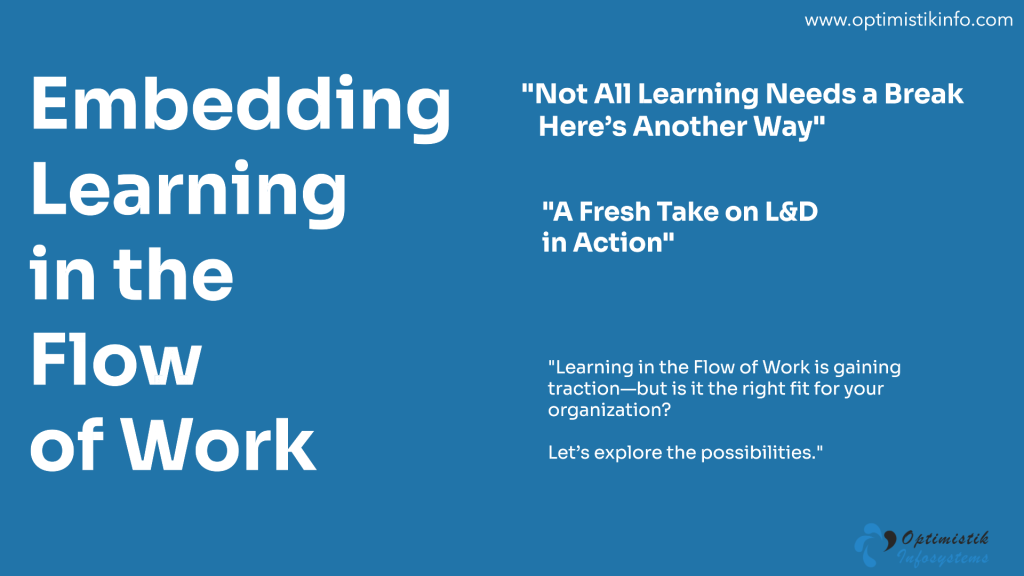
In today’s always-on, constantly evolving business landscape, how we approach workplace learning has never been more important. The demands on employees are higher, attention spans are shorter, and the shelf-life of skills is shrinking fast. Learning needs to be faster, more relevant, and easier to access. While traditional approaches to corporate training—like classroom sessions, eLearning modules, or structured certifications—still hold value, they often don’t fully align with the pace of modern work.
This is where Learning in the Flow of Work (LIFOW) comes into the picture. Not as a replacement for all other methods, but as a smart, contextual strategy to meet learners where they are. Especially for L&D professionals and senior IT leaders, exploring LIFOW offers a fresh and effective way to boost engagement, improve retention, and drive performance—without pulling people away from their core responsibilities.
What Exactly Is Learning in the Flow of Work?
Coined by industry analyst Josh Bersin, the concept of LIFOW is simple but powerful: Instead of taking employees out of their day-to-day jobs for formal learning, we bring learning resources into their day-to-day workflows. Whether it’s a quick how-to video embedded in your CRM, a short course recommended in Microsoft Teams, or a peer-shared tip in a Slack channel, LIFOW ensures that learning happens organically, contextually, and continuously.
It’s about learning at the speed of work.
Why Consider Embedding Learning?
Let’s be real: Formal training has its limits. According to multiple workplace studies, knowledge workers spend an average of just five minutes per day on formal learning. That’s not enough to keep up with rapid change, especially in tech-driven industries.
By embedding learning into the flow of work, companies can:
- Increase productivity: Real-time access to knowledge = faster decision-making and fewer delays.
- Boost engagement and retention: Employees feel supported and valued when their development is prioritized.
- Promote immediate skill application: Learning something and using it right away makes it stick better.
- Create a culture of growth: Continuous micro-learning becomes part of the everyday mindset.
Stats That Speak Volumes
Organizations adopting LIFOW have reported:
- 39% increase in productivity
- 47% reduction in stress levels
- 21% rise in employee confidence and happiness
- 23% boost in willingness to take on new responsibilities
Those are not just feel-good metrics. They directly link to business outcomes.
Let’s Not Throw Out Traditional Learning
To be clear, we’re not saying LIFOW is the only path forward. Some topics need deep dives, structured thinking, and instructor-led discussions. Compliance, leadership development, and complex technical upskilling often demand dedicated time away from the daily grind.
Think of LIFOW as a layer—not a replacement.
The goal is to create a blended learning ecosystem, where formal programs are supported by contextual, in-the-moment nudges and resources. The two can work together beautifully.
How to Operationalize LIFOW: Real-World Tactics
For L&D and IT leaders, the real magic happens in execution. Here’s how you can start integrating learning into everyday work:
1. Embed Learning in Core Tools
Inject bite-sized resources like checklists, short videos, and how-to guides directly into apps your teams use daily.
- Example: Customer service reps at Microsoft use just-in-time learning tips inside their CRM dashboard to resolve queries faster.
2. Personalize Learning with AI
Leverage AI-powered tools to recommend relevant content based on job role, recent activity, or performance feedback.
- Try: Tools that push personalized learning prompts in Microsoft Teams or Slack, triggered by employee behavior or milestones.
3. Encourage Learning Habits
Nudge employees to maintain “to-learn” lists alongside to-do lists. Create rituals around peer coaching, knowledge sharing, and curiosity-driven conversations.
- Leadership Tip: Managers should model learning behaviors—share articles, ask questions, celebrate growth moments.
4. Link Learning to Business Goals
Ensure every learning initiative ties into a clear performance metric or business outcome.
- Pro tip: Use data to continuously track what’s working (or not). Go beyond completion rates—track skill usage, performance changes, and feedback.
5. Use Tools Built for Flow-Based Learning
From Slack-based bots to mobile-friendly apps like Culture Amp’s Skills Coach, explore tools that deliver short, spaced learning bursts.
- Bonus: These tools often take less than 2 minutes a day but drive long-term behavioral change.
Overcoming the Real-World Challenges
Let’s be honest: this isn’t always easy. Here are a few friction points and how to address them:
- Information Overload: Consolidate resources. Use clean UX. Make content easy to find, skim, and apply.
- Cultural Resistance: Start small. Highlight success stories. Recognize and reward micro-learning wins.
- IT Friction: Choose integrations that are secure, scalable, and low-maintenance. IT and L&D must partner closely.
Real-World Successes to Learn From
- Microsoft embedded training into CRM systems, improving first-time resolution for customer issues.
- IBM delivered leadership micro-coaching within project management tools, offering timely support without scheduling a session.
These examples show it’s not just theory—LIFOW works when it’s thoughtfully implemented.
The Strategic Role of IT
For LIFOW to succeed, IT isn’t just a support function—it’s a strategic enabler. Their role includes:
- Ensuring smooth integration with enterprise systems
- Safeguarding data privacy and security
- Supporting content deployment and performance tracking
- Recommending and piloting scalable tech platforms
When L&D and IT teams collaborate, learning becomes a seamless part of the work ecosystem.
Final Thought: LIFOW Isn’t the Only Way, But It’s a Smart One
The modern workplace demands agile, adaptive learning. While formal programs still play a key role, embedding learning in the flow of work offers a compelling, people-centered alternative.
It’s not about jumping on a bandwagon. It’s about meeting learners where they are. Providing knowledge at the point of need. And creating systems that help people grow every day—without adding pressure or complexity.
So, is LIFOW the only solution? No.
But is it worth exploring? Absolutely.
Start Here: Audit your current learning touchpoints. Identify where real-time learning can make an impact. Pilot a few embedded learning ideas. Measure the outcomes. Iterate.
Because in the end, the organizations that learn fastest—win longest.